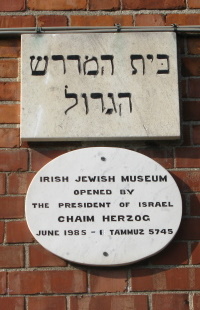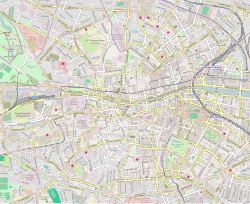The Irish Jewish Museum (Irish: Músaem Giúdach na hÉireann) is a small museum located in the once highly Jewish populated area of Portobello, around the South Circular Road, Dublin, dedicated to the history of the Irish Jewish community.
Músaem Giúdach na hÉireann | |
 Wall plaques at the Irish Jewish Museum. The inscription was intended to read as בּית המדרש הגדול (Bet HaMidrash HaGadol), Hebrew for "Great House of Learning" | |
| Established | 20 June 1985 |
|---|---|
| Location | 3 Walworth Road, Portobello, Dublin, Ireland |
| Coordinates | 53°19′51″N 6°16′11″W / 53.3307°N 6.2696°W |
| Type | Jewish museum |
| Public transit access | Harcourt Luas stop (Green Line) South Circular Road (Victoria St) bus stop |
| Website | www |
The museum was opened in June 1985 by Chaim Herzog who was then president of Israel and was born in Ireland. The museum is in a former Synagogue built in 1917 in two adjoining terraced houses on Walworth Road, off the South Circular Road. The surrounding area, Portobello, was previously a Jewish area, however the large scale emigration that affected Ireland in the 1950s had a particularly strong effect on the Jewish population; during this period there was a migration to the suburbs and Dublin's main synagogue shifted to Terenure. The synagogue is preserved, there are artifacts on display, and the museum houses genealogical records.
Contents and displays
editThe museum contains a substantial collection of memorabilia relating to the Irish Jewish communities and their various associations and contributions to present day Ireland. The material relates to the last 150 years and is associated with the communities of Dublin, Belfast, Cork, Derry, Drogheda, Limerick and Waterford.
The museum is divided into several distinct areas. In the entrance area and corridors there is a display of photographs, paintings, certificates and testimonials. The ground floor contains a general display relating to the commercial and social life of the Jewish community. A special feature adjoining the area is the kitchen depicting a typical Sabbath/Festival meal setting in a Jewish home in the late 19th/early 20th century in the neighbourhood.
Upstairs, the original Synagogue, with all its ritual fittings, is on view and also the Harold Smerling gallery containing Jewish religious objects.
2005 attacks
editIn 2005, the museum was sprayed several times with anti-Semitic slogans. Minister for Foreign Affairs Dermot Ahern visited the museum to express Government support for the museum and the Jewish community.[1] Ahern's actions were praised by Israeli Foreign Minister Silvan Shalom.[2] The culprit was identified from CCTV images and arrested. At trial, his lawyers stated that the attacks were a result of his ongoing schizophrenia and he was sentenced to six months of probation. Raphael Siev, curator of the museum, said the attacks had caused "great terror" and "great upset" but the trial judge prevented him from continuing, citing the uncertain legal status of victim impact statements in cases of this sort.[3]
Proposed development
editIn 2012, the museum began a fundraising campaign to expand and develop the site, under the auspices of the Office of Public Works. In December 2013, An Bord Pleanála voted 5 to 3 in favour of the plan, granting planning permission with a number of conditions. The plans include demolition of the original synagogue at numbers 3 and 4 Walworth Road, as well as the demolition of 3 houses at numbers 5 to 7 Walworth Road, a 6-metre basement excavation, and construction of a facsimile 19th century facade.[4][5] Taoiseach Enda Kenny supported the plan, describing it as an "exciting project... for the regeneration of the city”.[6] The plans were criticised by some local residents, councillors, and architects. 25 formal objections were submitted, citing facadism, destruction of the original synagogue, and lack of public engagement as the main reasons for opposition.[5][7][8]
See also
editReferences
edit- ^ "Anti-semitic attacks disgraceful, says Minister". 6 July 2005.
- ^ "Israelis praise minister's bid to stop attacks". 13 July 2005.
- ^ "Jewish buildings hit by graffiti attacks".
- ^ Barry, Aoife. "New, larger Irish Jewish Museum granted planning permission".
- ^ a b "Irish Jewish Museum planning ruling needs answers".
- ^ "Jewish museum receives Taoiseach's backing".
- ^ "Planned Jewish museum strikes discordant note - Independent.ie".
- ^ "Residents appeal against redevelopment of Irish Jewish Museum in Dublin".
External links
edit- Official website
- Zeitlin, Marilyn (13 March 2007). "A Slice of Ireland A Museum Struggles To Survive (issue of March 16, 2007)". The Forward. Retrieved 6 November 2012.
- An article about the proposed expansion of the Irish Jewish Museum, from 2013, with photographs
- The Irish Jewish Museum on visitdublin.com, the official tourist website
- News item about Dermot Ahern's visit
